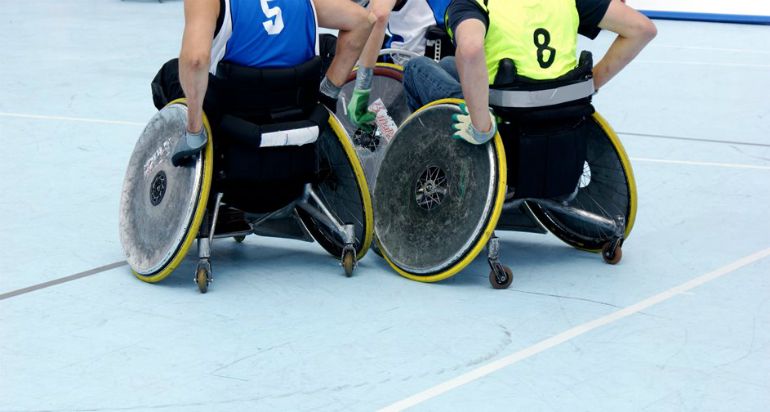Share:
Take it offline!
This Education in Motion resource is also available as a printable PDF.
Download PDF
With a nickname like ‘murderball’ wheelchair rugby often has a reputation of being a violent sport and it is certainly one of the adapted sports with the most contact. With this in mind there are several tactical and safety issues that players must be aware of.
Rules of wheelchair rugby
One of the main advantages of wheelchair rugby is that it can involve any disabled persons, even those who suffer severe injuries that affect the upper and lower limbs (spinal cord injuries, cerebral palsy, amputations or deformities) making it an extremely integrative sport.
Perhaps this is why wheelchair rugby, also called Quad Rugby, has achieved remarkable success. Wheelchair rugby originated in Canada in the seventies and is becoming increasingly popular with more and more people talking about the physical and mental benefits of playing it.
Rugby adaptions for the wheelchair: field, ball and fouls
The characteristics of traditional rugby (type of field, scrums, tackles) make wheelchair rugby one of the sports that requires the most adaptation. Even so, it retains much of the essence of the original game when, for example, passing the ball, or to make the desirable tries across the line of the opposing team.
One of the key adaptations of wheelchair rugby is the field. Quad Rugby is played on a basketball court in which two goals are created, usually marked with two cones.

To score a try, you need to cross the baseline whilst holding the ball tightly. Because wheelchair rugby allows players with severe injuries to participate, a round ball is used, similar to a volleyball, as a conventional oval-shaped rugby ball is more difficult to hold.
Wheelchair rugby matches are divided into quarters of eight minutes. The possession time of the ball per player is, a priori, indeterminate. The plays per team cannot exceed 40 seconds, and each player must throw the ball at least every ten seconds. The objective of this rule is to make the game more dynamic. Otherwise players can carry the ball in their legs, bounce or pass it - but never forward.
In wheelchair rugby, the ‘back field’, physical contact between players and the back posts are deemed fouls and are penalised with either with one-minute penalties or until they mark the team of the offending player.
Configuration of the teams and types of wheelchair in wheelchair rugby
There are two types of chairs used in wheelchair rugby that vary depending on whether the player is in an attack or defence position. Attack wheelchairs have front bumpers while defence wheelchairs feature an attachment, also at the front, to prevent attacks from the opposing team.
These attachments should always be used at the front, never behind and are designed so that they don’t get caught with each other. In wheelchair rugby, contact with chairs is permitted but not between players.
Wheelchair rugby teams can be mixed and, as in wheelchair basketball, players are ranked according to their functional ability from 0.5 to 3.5, with the highest score corresponding to greater functionality. The teams, made up of a maximum of four people, should never exceed eight points on the field.
Despite being invented in 1977, wheelchair rugby wasn’t seen as an exhibition sport until the Atlanta Olympics (1996) and it was not until Sydney (2000) when it was first played as a Paralympic Sport. The International Wheelchair Rugby Federation (IWRF) regulates the practice of this sport internationally.
Want to get sporty? Take a look at Sunrise Medical’s range of sports wheelchairs.